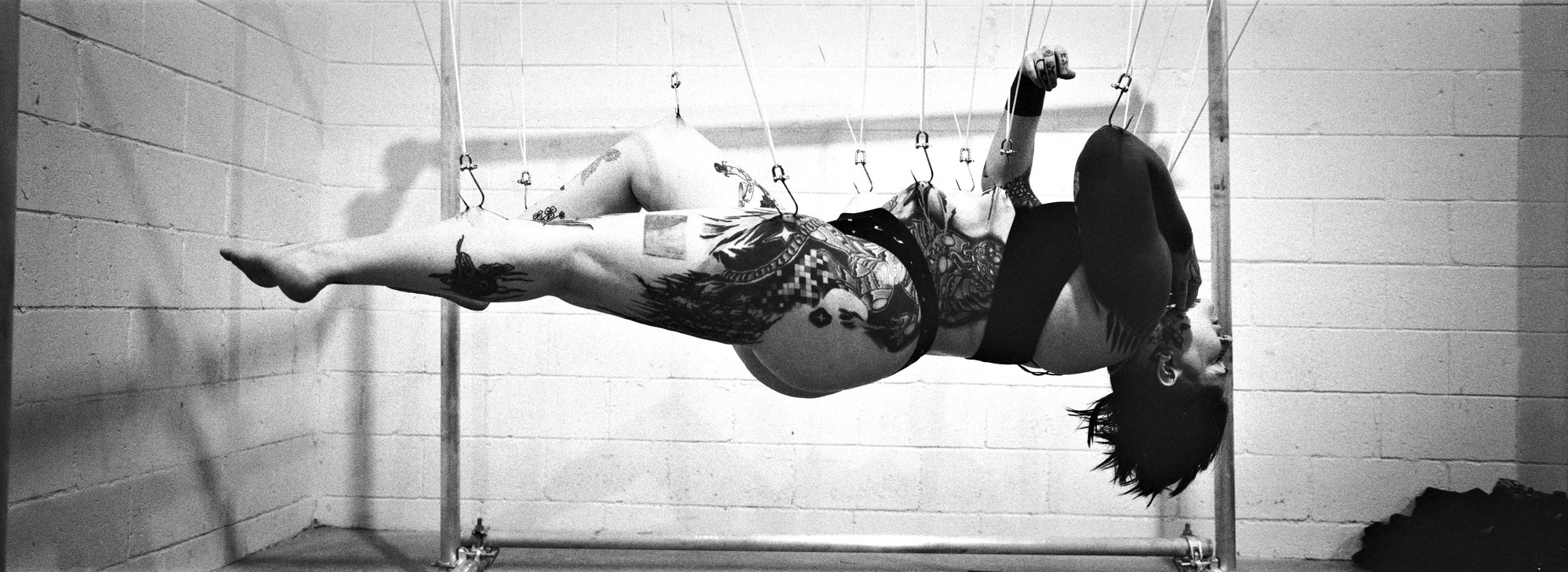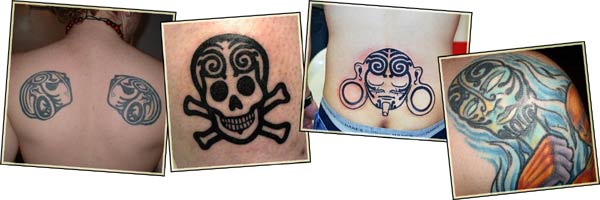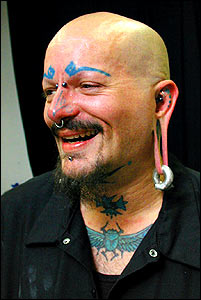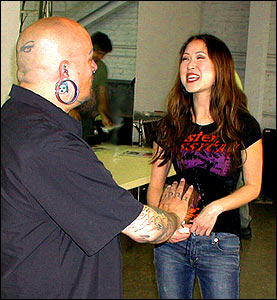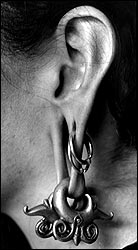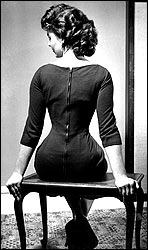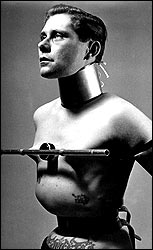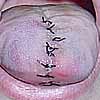
|
“The best laid schemes o’ mice an’ men / Gang aft a-gley,
An’ Lea’e us nought but grief an’ pain / For promis’d joy.”– Robert Burns
Over the past six months I’ve been contacted by an increasing number of piercers and amateur activists complaining of perceived problems in the piercing industry, and seeking my help in pushing through regulations of various kinds to combat them. Most of these piercers are talented and experienced and often some of the best in the industry. While being very clear that I’m not attacking them, but simply their methods, what I’d like to show in this column is that while their actions are well-meaning, they are ultimately misguided and perhaps even destructive to the body modification community.
The first thing that should be addressed is that the piercing industry is only a very small part of the (atypical) body modification community. The piercing industry represents the commercial application of a very small subset of this community’s interests and because of it being a mass-market commercial application, there are certain incompatibilities, since one is built around the individual, and the other around larger issues such as public safety, contract law, and business ethics… all concepts which often run contrary to the extremist individual freedoms embraced by those drawn to atypical body modification, as well as the ever broadening freedoms being demanded by modern societies.
The big first question from my point of view is “why now?”
Why wasn’t the piercing community aggressively pushing for regulation five or ten years ago? At its simplest, the golden age of piercing is over. Five years ago shops regularly had “thousand dollar days” and there was more than enough business to go around. In 2003, competition is heavy, the market is saturated, and profit margins are lower and lower. Aging piercers are realizing that they’ve been putting long hours into what may be a dead-end job, and are asking themselves what the future holds — and how they can secure that future.
It’s expensive to run a good shop. Customers are rarely willing to pay more for high quality jewelry, and far too few are even willing to discriminate by the safety practices of the studio. As such, with pricing being equal, the better a studio is, the less money its owners and staff take home with them. It’s very easy for unscrupulous studios to legally undercut prices by reducing quality and seize a significant market share in exchange for cutting corners and providing substandard service — but let’s face it — that’s true in every industry, and it’s what makes capitalism work!
In response, a number of well-meaning good piercers are trying to push through regulation that would force every studio to conform to their tightly bordered and high-end standards. Much of the time this is accomplished by pointing out the many problems that arise from not maintaining those standards — slightly elevated (but still very manageable) rates of infection and complication, more young people with piercings (as if that’s a bad thing), and so on. This is further sought by publishing “scare articles”, citing their qualifications as required knowlege (nursing skills, CPR courses, and so on; all excellent knowledge to have as a piercer, but whether it’s required is very much up for debate), and generally using an approach of attacking others (often validly) to make themselves look better.
In light of recent attention by the mainstream media on procedures such as tongue splitting, others will make extremely negative statements about heavy mods and the artists that embrace them in an attempt to make themselves appear more responsible. I suppose they feel that painting others in the most dangerous, frightening, and irresponsible manner will make them appear more responsible to the mainstream in juxtaposition.
Problem is, that doesn’t work.
First of all, we need to realize that the majority of politicians (and media) are not involved in the body modification community and often don’t like piercing and see it with a preexisting set of prejudices. As such, they won’t see any juxtaposition of “high quality” versus problem studios — they will simply see the problems and, like all bigots, stereotype our entire community by the acts of the worst of the bunch.
Second of all, we need to acknowledge that there is no central professional organization of piercers for regulators to work with in drafting balanced legislation. While groups such as the APP have made excellent progress over the last decade, they still represent only a very tiny percentage of piercers. Almost all attempts to form such organizations have eventually degraded to infighting and apathy.
Because of those two factors, much of the political action on piercing is either pushed through by a individual piercers who don’t represent the industry on the whole, or, worse yet, by politicians working with doctors who don’t have any comprehension of or sympathy for atypical body modification. When this occurs we tend to see things much like gay sex laws — heterosexual sex is typically legal at 16, with homosexual sex not becoming legal until 18, and we see piercing being restricted to 18 even though cosmetic surgery is permitted at 16. In addition, we tend to end up with tightly defined rules which restrict jewelry use, procedures, and even aftercare to only one possibility. Since piercing is still very much evolving and improving, locking its growth like this is a potentially harmful act, and tends to restrict valid and sometimes even superior methods — as illustrated by some areas’ bans on dermal punches, scalpels, and other needle alternatives.
We also need to recognize that what an industry perceives as being right for it is not always right for the surrounding community (or from the industry’s point of view, the customer). The actions of groups like the RIAA are good examples of that of course, where we are watching a power shift from the music listener and the musician to the corporate distribution channels.
So what should we do? How can we ensure a high quality piercing industry that encourages the growth of the body modification community, gives consumers a range of options, while still ensuring basic safety?
Now, I’m not about to propose that this should be an absolutely unregulated industry; simply that we need to balance individual freedoms and public safety. Clearly we need to ensure minimum standards as far as sterility goes and making certain that regulation controlling contamination are adhered to — no studio has a right to willfully and negligently endanger its clients. I’m happy to say that a growing majority of jurisdictions have already enacted such laws covering piercing studios, nail salons, dentists offices, and so on. I am fully in support of such laws. They restrict no one’s freedoms and simply increase the safety level.
My focus with BME will continue to be education over regulation. This is why I dedicate resources to developing FAQ documents, BME/Risks, and work to get qualified authors writing columns. An educated consumer base will make the decisions that it sees fit for itself — and we do have the right to purchase low quality product should we choose to. After all, assuming base standards are in place, the worst that can occur from a lower-end studio under normal circumstances is a small scar. Given that we allow — and even encourage — the consumption of junk food and candy by even young children, thereby damning them to live in the most obese and unhealthy culture in human history (in effect allowing corporations to market a product that shaves 15 years or more off a person’s life), it seems somewhat hypocritical to suggest that we should restrict piercing to only the most conservative, limited, and safe options?
As far as age standards go — and we do need to strike a balance between the rights of parents, the rights of youths, protecting against predatory piercers, while making sure not to fall prey to ageism — we must create them in context with other age restrictions. It’s too easy to allow politicans to force into place high age restrictions as a shallow cover for an attempt to ban and keep piercings out of schools and so on. We allow youths to sign for surgery and drive at 16. We allow youths to sign for abortions without parental consent at as young as 14. We allow marriage and sex at 16 in most areas, and we even allow firearms to be owned by teens… If we are then to restrict piercing to 18, we need to justify how piercing is more dangerous than these acts and why comprehending them is out of the range of a young person’s ability. From my point of view piercing is a safe and excellent way for young people to practice independence and responsibility, and I worry that when we spend so much effort telling young people that they are immature that they will be utterly unprepared for the world when they reach adulthood.
I mentioned earlier that I believe informed consumers can make a good decision. Because of that, one type of regulation that I would like to see in place is disclosure laws. We require food manufacturers to place ingredients and nutritional information on the packaging in order to allow consumers to make an informed decision. We require auto manufacturers to disclose pollution and mileage data. Why should piercing studios not be required to state what material their jewelry is manufactured from? Without this information, the average consumer can’t tell if they are being sold a $1 mass-manufactured barbell made of cheap low-grade steel, or whether it’s a $20 piece of “implant grade” jewelery — while the vast majority of people can heal a piercing just fine with the cheap stuff, it will take a bit longer, the complication rate will be a fraction higher, and some people will have reactions. Certainly someone should have a right to choose that path, but I do not believe that a studio has the right to surreptitiously impose that path on unwitting customers.
Ultimately though there is only one way to guarantee a high quality industry: Consumers must, on their own, decide to support high quality studios. Poor quality studios don’t thrive in a vacuum — they thrive because of their large customer base. If you’re reading this, you probably have the knowledge required to judge which studios in your area are the good ones. Tell your friends. Write experiences about them. Tell the piercers why you go to their studio and not another, and tip them appropriately. People have a choice in life — all of our laws make it clear that we believe as a culture that people have a right to make bad decisions and purchase an ill-advised product should they choose to. Why should piercing be different? Are we really comfortable with ours being the one industry that’s tightly restricted and dictated by the whims of politicians?
To the piercers who are pushing for these laws, while I applaud what you are attempting to achieve (a high quality industry), I hope you consider that your actions may not achieve your goals, and could in fact have the opposite effect. There are better ways. Make sure that when you push for regulation and make public comment, you push for minimum standards and disclosure laws, and not for self-serving regulation that may come back to haunt us all, and that you respect the right of others to make their own informed decisions, even if you disagree.
Thank you,

Shannon Larratt
BME.com

